
Die Struck Forgeries…
Genuine ancient bronze coins usually have a patina hiding the original surfaces. Fake ancient bronze coins usually have a false patina applied to mask signs of forgery. This makes casting methods the easier method for faking bronzes. While die struck fake ancient bronzes exist, this discussion will focus on silver and gold coins, although most of what I discuss will still applies to bronze coins.
There are many technical issues forgers face attempting to approximate the look and feel of genuine ancient coins, and for silver and gold coins not encrusted with a heavy patina die striking is the only option for coming close.
The Surfaces
The overall look and feel of a genuine ancient coin is in part the result of microscopic surface textures created by the striking process. As discussed on previous pages, castings and electrotypes cannot reproduce the luster seen on gold and silver coins because the metal never flowed into a die low under the high pressure and sudden impact of a hammer strike.
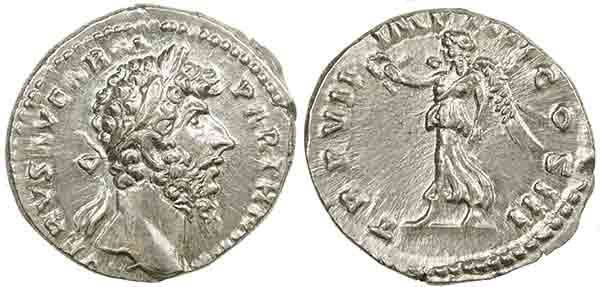
Luster is difficult to photograph and the best I could is this Lucius Verus denarius which is a fully lustrous coin but only a bit of the luster shows on the image. It also exhibits a feature common on ancient coins that is often mistaken for luster.
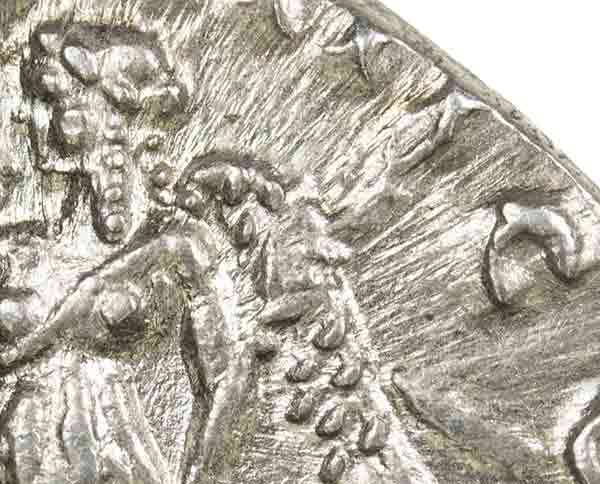
The fine radiating lines between the letters and victory’s wings is actually die deterioration resulting metal flowing across the die carving tiny groves in the die. These are a macro feature the best castings can copy. True luster is created by much smaller features and visible to us only by the way they reflect light, visible on this image as the bright reflections along Victory’s forearm and the edges of some letters. Hold a coin under a bright light and rock the coin and true luster will appear to move slightly while the die deterioration lines stay in place. Luster wears off quickly but will be preserved on even low grade ancient silver or gold coins in protected areas such as below a bust truncation or inside of a letter. Harsh cleaning might remove it even in those areas but I recommend not buying harshly cleaned coins that show no luster as authentication becomes problematical.
Hammer striking methods used by the ancient mints had no problem producing lustrous coins but people attempting to replicate the methods have rarely managed get a good strike. I will not discuss here what they are doing wrong as I don’t wish to have forgers idea on how to improve their methods, but they also have mostly failed and many resort to presses that will strike a coin but slowly at lower pressures and fail to produce much if any luster.
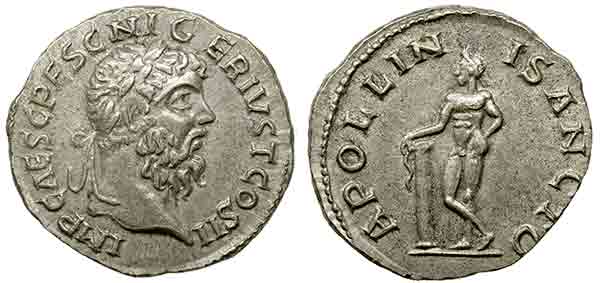
This fake Pescennius Niger denarius is such a pressed coin with just the barest traces of luster round the edges but none along the designs or lettering. It is important to remember lack of luster makes a coin highly suspect and in need of further investigation but presence of luster does not along authenticity. Some forgeries are better than others.
Another feature of this fake is the very even strike showing the dies were perfectly perpendicular to each other. While an authentic ancient coin can have this feature, every few do as the hand striking process was done very quickly without overly careful positioning of the dies. Most ancient coins will be weaker along one edge than the other, at least a little.Together these two features indicate a pressed rather than hammer struck coins. Once you look at enough genuine coins, these differences will become obvious to you almost at a glance.
The Images
There are several ways to create false dies, each presenting a different set of challenges to the forger. I will discuss the more commonly used ones.
Spark Erosion dies
Spark erosion is an industrial process with industrial uses where an object such as a coin is placed on a blank die, electric current is passed between them, eroding an impression of the coin into the die. This YouTube video shows the process used for an industrial object.
Spark erosion can copy the major design details fairly well, but may miss the smallest one. It leaves a granular texture on the die face which is a problem and while it can be polished off, it is difficult to polish into the same protected places luster is usually preserved on genuine coins and stops luster from forming there.
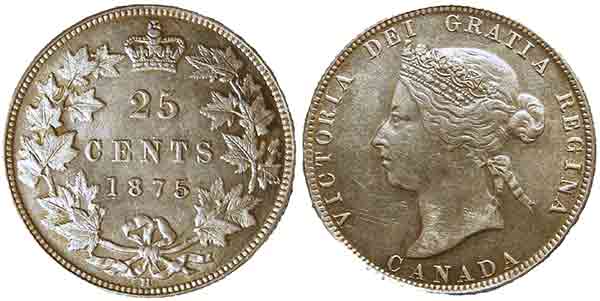
The method is not very good it is seldom used for ancient coins and I do not have an example to photograph, but it is commonly used for false modern coins as this Canadian 1872 25 cent made in China. As you can see the overall image was fairly accurate but the coin has an unusual matte finish that is incorrect for one of these. Along the edges of designs and letters it has very course textures one would never see on a genuine one, but I was not able to take a photograph good enough to show this. Once you understand these textures, you should never be fooled by a coin struck with spark erosion dies. I was shown this coin by someone attempting to sell it as original, and I was lucky to get even this image of it. When opportunity present I will do better photographs of these features.
Impressed Dies
A hub is a positive image used to impress a die. Forgers can use a genuine ancient coin as a hub to impress a false die. The advantage is a false die the image and style of the genuine coin. The disadvantage is a genuine coin is not an exact duplicate of the original die from which it was struck.
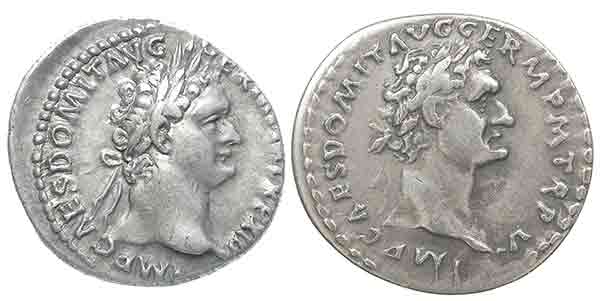
The disadvantage is that a genuine coin is not an exact duplicate of the features on the die that struck it, so the die produced this way is not an exact copy of the original ancient die. The Domitian denarius on the right is fake, struck from a false die created using a genuine coin very similar to that on the left as a hub.
Note the missing beads on both coins. Genuine coins rarely have the full ring of beads and often not even all the lettering. The beads missing at the top of this genuine coin are missing due to centering. Now look at the missing beads at the bottom of the fake coin where it is not that poorly centered. They are missing because they were never on the die in the first place, having used a genuine coin without those beads as the hub..
As a coin is die struck metal pushed into the designs at high pressure, molding exactly to the die. As the coin released from the die that metal relaxes and deforms slightly in what I call the rebound effect. Feature usually spread and lower slightly. If coin is then used as a hub to impress a false die, the deformed features are what is copied. Strike a coin with the false die, you get another rebound effect and the false coin has even further deformed features, which why the letters and hair details on this fake coin are so odd yet the overall style is retained.
Often the hub is not fully impressed into the false die and details that are the lowest on the coin are not reproduced. Notice the weak and missing details at the laurel ties behind the head, all around the nose and mouth and at the left edge of the shoulder. The nose appears slightly detached from the face in what I call the floating in water effect as it looks as if the profile is floating in water with some parts just below the surface. This is another characteristic common to impression dies.
In the past only metal dies could strike a metal coin but new plastics and ceramics are now available which can take very good impressions and stand up to a few strikes on gold and silver. This short die life is not a problem as dies are easy and cheap to make quickly. This helps with the floating in water effect but does not eliminate the distortion problems.
In my examples section I discuss a fake Diocletian aureus struck from impressed dies, possibly a plastic die. I had the good fortune of finding and image of the exact coin used as the so can show them side by side. It made a more convincing fake than this Domitian denarius, but there are features that show it for what it is.
Pantograph dies
A pantograph is a device used to copy an object by tracing it on one end while guiding a cutter on the other. Until recently most modern mints designed coins by sculpted a large version then copying it with a reducing pantograph guiding a die cutter. The limiting factor was the size of tracing point and the size of the cutter and worked best if the master was large and the final die small. Older pantograph dies would need the forger to touch up the die to add in details that the pantograph could not copy.
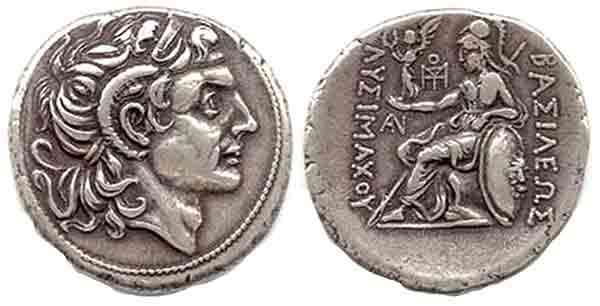
This Lysimacos tetradrachm appears to be from pantograph dies copying a slightly worn original coin. The overall effect is pretty good but the pantograph failed to copy some of the fine details at the back of the hair which the forger engraved into the die. He copied from a slightly worn coin so his fake appears slightly even when freshly minted, altough I think it was subjected to a little artificial wear as well.
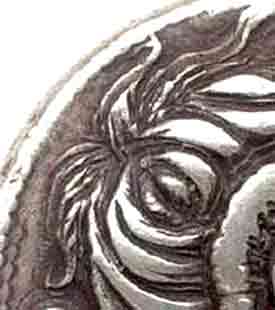
Note how the hair at the very back of the head is very sharp compared to the rest of the coin. I believe those hair lines were sharpened on the die by the forger, having been poorly replicated. There is also something slightly odd about the portrait which results from the rebound effect slightly distorting many small details of the coin, which is a problem pantograph dies cannot compensate for.
Pantograph dies also have a problem with the tool marks modern cutters leave on a die being different than those ancient tools leave on the dies. That problem also exists for hand cut dies and I will go into that more in the next section.
Hand-Cut Dies
Some forgers hand cut dies, which can mean total hand cutting or creating an impression or pantograph die and then touching up all details to eliminate the floating in water and the metal rebound effects. Forgers working this way seldom get a good result but there are some who are more talented and get fairly good but never prefect results.
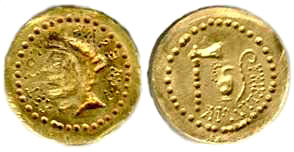
Image that shows the coin as a positive.
These modern hand cut dies for a gold aureus of Julius Caesar were found discovered in a Spanish flea market. The image provided by Mr. Ramon of Spain, used with his permission. Our brains have evolved for facial recognition and even tiny differences between how a face looks and what our brains expect are instantly noticed. This is less true for inanimate objects, which is why the face on these dies looks all wrong and the reverse less so even though both are not really very close to what they should be. This is not a very good fake.
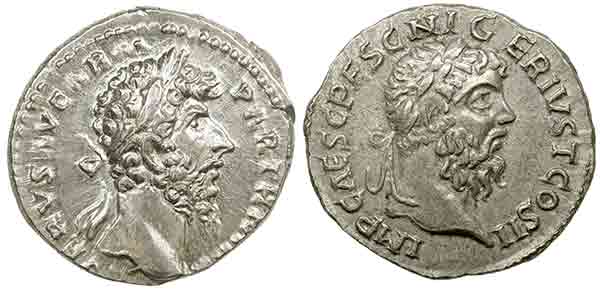
The letters on the genuine Lucius Verus denarii on the left vary in size, quality of calligraphy, depth cut into the die, plus the letters are more or less wedge shaped. This shows imprecise hand cutting with simple hand tools. The fake Pescennius Niger on the right has letters nearly all the same size, more precise calligraphy, with every cut almost exactly the same depth, which showing more sophisticated modern tools, possibly machine guided were used
Many people confuse design and style. Design is what is depicted. Style is how it is depicted in terms of the tiny details of how the celator cuts features into the die. Designs are easy to cut, but styles are nearly impossible to copy. It understand why, you have to understand sight is not a simply transfer of light to your brain through your eyes. What you think of as sight is electrochemical impulses sent from your eyes to your brain which you brain must interpret.

Most people looking at this picture flip back and forth between seeing a goblet or two faces. This happens as your brain cannot decide what it is seeing, and keeps changing it interpretation. It is important to understand this so that you can understand a forger copying a genuine coin in front of him is not copying the coin; he is copying his brains interpretation of the coin and just as his interpretation of the optical illusion is not perfect, neither will be his interpretation of the coin and thus is die cannot be an exact copy of the true coin, but when he looks at his finished product he may believe it is identical. Some one else looking at the coin will have a very slightly different interpretation of it. When he looks at the forgers work the tiny differences the forger cannot see will be noticable. This is what makes copying a style virtually impossible and is one of the cores of art authentication.
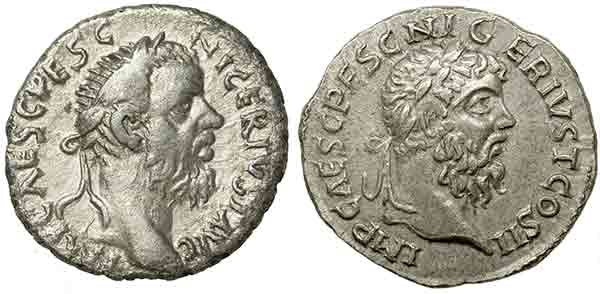
The Pescennius Niger denarius on the left is genuine and that on the right false. Look carefully at the small details such as individual lines in the hair and beard, the exact way the eye was done, how the ear was formed. Each of those is formed of even smaller details. The over all design of the two coins is the same. The style is completely different and you know immediately they are not the work of the same celator. Most ancient coin types come from dies engraved by no more than a handful of celators, often only two. Each celator has a distinct style that will be consistent across his work. With experience in a series one can learn to recognize the correct styles for an issue. When you see one that strikes you of being a very different style than expected, you should investigate further.
The next problem modern forger’s encounter are the microscopic tool marks that show how and with what he cut the die. A perfect die requires cutting with the same tools and methods used for the original dies. Traces of tools marks on a die can usually be seen on coins struck from that die. Modern forgers usually use modern tools and techniques different from ancient one and a good microscopy or digital camera can let us see the difference.
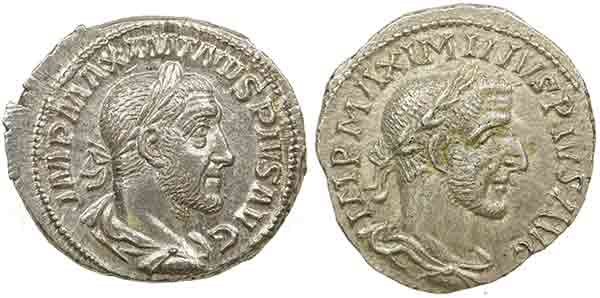
If familiar with the correct style for a Maximinus I denarius it is obvious the genuine one is on the left and the fake to the right, but now look at the tools marks form cutting the hair details.
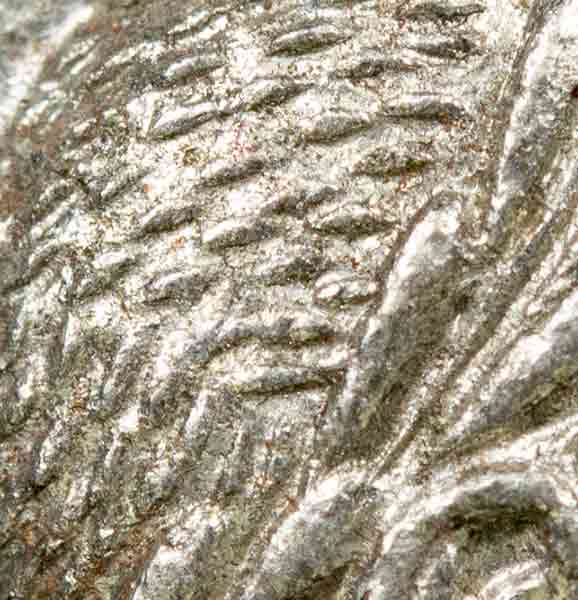
On the genuine coin the individual hair lines are very regular as slightly pointed end ovals, resulting from a specific ancient cutting technique.
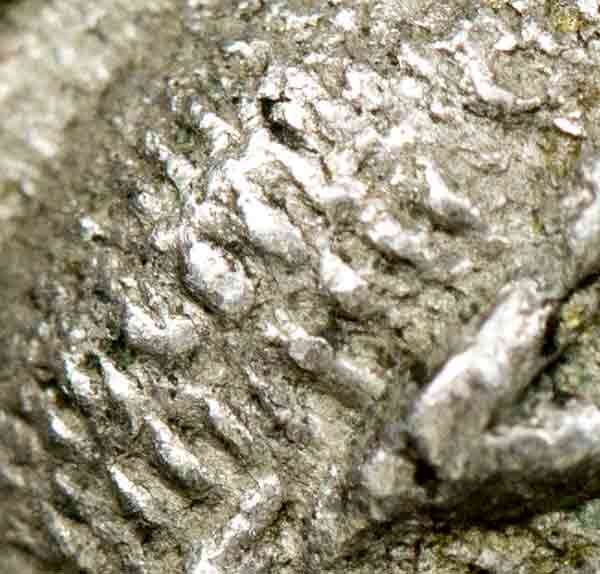
On the fake the individual hair lines are very irregular in pattern and individual shapes, resulting from the use of a pointed engraving tool gouging the lines into the die. Ancient celators lacked gouging tools good enough to cut into a metal die quickly like this, so used a different method. If viewing the coin without magnification the hair details look very similar, but a high magnificent they are very different.
This is just an introduction to the obstacles modern forgers face when trying to hand cut false dies, but hopefully explains why there can never be prefect hand cut dies
Flans
Should a forger mange to make a fairly good false die, and find a way to strike the coins fairly well with hammer striking, he still have to strike on a blank flan made by the same methods the ancients made theirs. The ancient developed a number of flan productions methods, but usually one will have been used on any series of coins. If the forger does not understand the methods so cannot replicate them, or uses the wrong method for the coin he is trying to copy, it will be one more way his forgery can be exposed.
Evidence of how a flan was made will exist on the coin’s edges. You can go a long way learning to authenticate coins by studying their edges.
Mixed methods
The most dangerous fakes you are likely to encounter combining forgery methods.
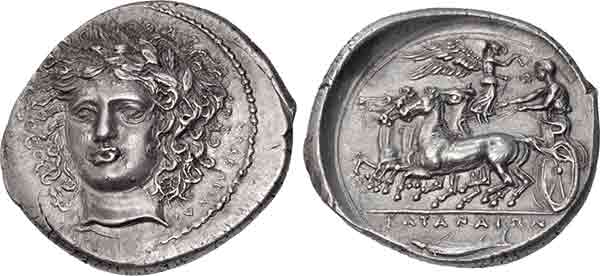
image from the CNG website (www.cngcoins.com)
This Katana tetradrachm is in my opinion the pinnacle of the forger’s art. The die production was a complicated process involving multiple methods. The flan has all the right edge characteristics because it was almost certain struck on and genuine but common coin. It comes as close as I have ever seen to a perfect fake. But it is not perfect and the more you study it the less perfect it will seem. I discuss this coin in great detail in the examples section.
Modern die struck fakes can never produce a perfect fake
but some are pretty good.
Die Struck Forgeries
We hope you have found it helpful.
Source: calgarycoin.com
See more: fakeart.eu






